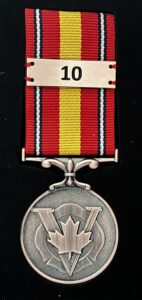CVFSA Fire Service Award (10 – 29 years of service)

CVFSA Fire Service Award
Fire Service Medal (10 to 29 years of Service)
The Canadian Volunteer Fire Service Association has developed the Fire Service Award for those who have 10 to 29 years’ service within a Volunteer Fire Department. Anniversary service bars can be added every five (5) years. After 30 years’ service, the individual would transition to the CVFSA Municipal Long Service Award Medal program.
Implementation of the program will commence in October 2024.
The CVFSA has created an online record of the recipients in a national database for recognition by their peers, their families and members of the public who have an interest in the fire service. The CVFSA will maintain an inventory and supply of the service medals that can be shipped to your community.
Eligibility:
Municipal Leaders and Senior Fire Officials may nominate a volunteer or volunteer-paid-on-call fire services member who has served at least 10 years for a recognized fire service or medical first responder provider in Canada, for the Fire Service Award Medal for 1O years of fire service and for each five (5) subsequent years of service. Use the “Fire Service Award and Bars Application” form to nominate a fire service member for the fire service medal or bar. Those medals sponsored by a Municipality must be signed by a Municipal Leader and/or a Senior Fire Official including Fire Chief, Deputy or Assistant Chief.
How to apply:
Complete the application form and ensure all boxes are filled in. Check the application for details on supporting documents. Send your completed application by email to: fsam@cvfsa.ca
How long does it take:
Applications should be submitted eight (8) weeks prior to the Award presentation.
In special circumstances, we may be able to fulfill your request earlier than eight (8) weeks.
Cost (per medal):
There is a sponsorship fee of $75 for each medal, including undress ribbon, plus shipping (first time recipient). Subsequent anniversary award kits cost $32 plus shipping and include the bar and undress ribbon. If you require more information submit questions to: fsam@cvfsa.ca
Payment Options:
Credit Card, Cheques as well as Purchase Orders.
CVFSA will invoice your organization upon shipment.
Precedence and Wear of Medals and Undress Ribbons:
- a) Generally, the wear of medals and undress medal ribbon bars shall follow the Order of Precedence published from time-to-time by the Canadian Chancellery of Orders. Medals Awarded by a province shall in all cases be worn in lower precedence to medals Awarded by the federal government and their order of precedence shall be determined by the date on which they were first established.
- b) Medals Awarded by the Canadian government and by a Provincial government (deemed to be Awarded in right of the monarchy) shall be worn in the correct order of precedence (see “a” above) on the left chest of the dress tunic positioned so that the top of the medal ribbon(s) is aligned vertically with the top of the name tag on the right chest and centered on the left chest pocket flap. Where no pocket flap exists, the medals shall be mounted on the left chest, centred between the collar and the sleeve and laying with the top of the medal ribbon(s) centred at 220mm from the shoulder seam.
- c) Medals Awarded by an Indigenous, Metis and Inuit communities, municipality, a fire service, or other partner entities shall be worn on the right chest, the order of precedence shall be determined according to the time of establishment of each medal. These medals shall be worn centred on the right pocket with the top of the ribbons aligned vertically with the medal ribbon(s) on the left. Where no pocket flap exists, the medal(s) shall be mounted on the right chest, centred between the collar and the sleeve.
- d) Those Awarded more than one medal, whether issued in right of the monarchy or by another agency, should endeavor to have them appropriately ‘court mounted’ to ensure proper precedence of position and uniform and symmetrical appearance on the tunic. If more than five medals are to be court mounted together, it may be necessary to slightly overlap the medals. The highest precedence medal shall be fully visible.
- e) Assembly of the undress ribbon bar(s) shall follow the precedence established above and shall be worn on the dress uniform shirt, station wear shirt, or station wear jacket centred on the appropriate pocket with the bottom edge of the medal bar immediately above the pocket flap seam. Undress ribbon bars or medal miniatures may be worn for formal occasions on a suit jacket, or tuxedo jacket on the left or right chest as appropriate (see “b” and “c” above).
- f) Undress ribbon bars shall not exceed three ribbons wide. If more than three ribbons are to be worn together, the undress ribbon bar shall be assembled with three ribbons in as many tiers as required with the highest precedence ribbon(s) at the top of the assembly nearest the chest centre or centred on the top row.
Frequently Asked Questions
What is the difference between the Fire Service Award and the Municipal Long Service Award?
The Municipal Long Service Award has been available since December 2013. The criteria for this medal is 30 years’ service. Recognizing many volunteer firefighters are no longer obtaining 30 years of service we wanted to a way to recognize the service of those who serve a minimum of 10 years. The answer was to create the Fire Service Award. The Fire Service Award is only available to those with 10 to 29 years’ service. Once an individual reaches the 30-year anniversary, they would transition to the already existing Municipal Long Service Award. Although the two medals have the same ribbon, the medal itself is Antique Copper (10 to 29 years’ service), Nickel (30 to 49 years’ service) and Gold (50 years and greater service)
Who can be nominated?
Any person who has served as a member of a volunteer fire service for a minimum of 10 years. Retired members with eligible years of service may be considered if their department decides to recognize their years of service.
Who can nominate?
In most cases it will be senior fire officers, primarily Fire Chief, Assistant or Deputy Fire Chief. Community Leadership can nominate senior fire officers. Peer to peer nominations are not accepted.
FSAM APPLICATION FORM – Form for submitting applications for Award
Download a PDF copy of this information.



